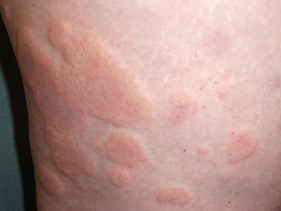Urticaria, Hives. Allergy, Angioedema
Red, bumpy, scaly, itchy, swollen skin-any of these symptoms can signify an allergic skin condition. These skin problems are often caused by an immune system reaction, signifying an allergy. Allergic skin conditions can take several forms and are due to various causes
Hives and angioedema
Hives or urticaria are red, itchy, swollen areas of the skin that can range in size and appear anywhere on the body. Approximately 25% of the population will experience an episode of hives at least once in their lives. Most common are acute cases of hives, where the cause is identifiable-often a viral infection, drug, food or latex. These hives usually go away spontaneously. Some people have chronic hives that occur almost daily for months to years. For these individuals, various circumstances or events, such as scratching, pressure or “nerves,” may aggravate their hives. However, eliminating these triggers has little effect on this condition.
Angioedema, a swelling of the deeper layers of the skin, sometimes occurs with hives. Angioedema is not red or itchy, and most often occurs in soft tissue such as the eyelids, mouth or genitals. Hives and angioedema may appear together or separately on the body. Hives are the result of a chemical called histamine-responsible for many of the symptoms of allergic reactions-in the upper layers of the skin. Angioedema results from the actions of these chemicals in the deeper layers of the skin. These chemicals are usually stored in our bodies’ mast cells, which are cells heavily involved in allergic reactions. There are several identifiable triggers that release histamine and other chemicals from the mast cells, causing hives.
In adults, reactions to medicines are a common cause of acute hives. Medications known to cause hives or angioedema include aspirin and other non-steroidal anti-inflammatory drugs (NSAIDs) such as ibuprofen, high blood pressure medicines known as ACE-inhibitors, or pain-killers containing codeine or codeine-like drugs. Like all drug-induced hives, these reactions occur within only minutes to an hour of taking the drug. Adults can also develop hives after eating certain foods, including nuts, eggs, shellfish, soy, wheat or milk-the culprits in more than 90% of proven food-induced hives. In children, foods or viral infections such as a cold can trigger acute hives. Physical urticaria are hives resulting from an outside source: rubbing of the skin, cold, heat, physical exertion or exercise, pressure or direct exposure to sunlight. Patients with chronic urticaria often report that at least one of these triggers induces their hives.
Whenever there is an identifiable trigger of hives, it should be eliminated. In patients with acute hives, some drugs or foods may take days to be eliminated from the body. For these individuals, an allergist may prescribe antihistamines to relieve symptoms until the culprit is eliminated.
Treatment
Aconite Nap, Apis Mel, Nat Mur , Urtica U. Astacus F. and etc….. are use successfully for this treatment, For your prescription we require some detail for that send detail if possible send photographs of your eye.

